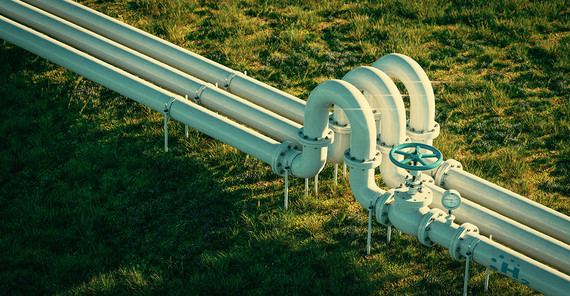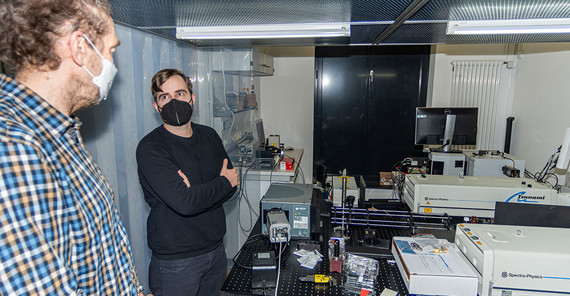Water can indeed be split into its components by using energy. The resulting hydrogen is a true all-rounder: It can be used as a chemical energy storage system, as fuel for engines, or in fuel cells to generate energy and heat. If energy from renewable sources such as wind and sun is used for its production, the resulting hydrogen is classified as “green hydrogen”. This is climate-neutral and produces no CO2 emissions. In the coming decades, hydrogen is expected to be used comprehensively and in large quantities, driving forward the energy transition.
Gas leaks are detected with the help of lasers
“This is a long-term project,” says Dr. Ingo Gersonde about the planned large-scale use of hydrogen. A lot of research still needs to be done to make hydrogen the energy source of the future. Physicist Gersonde and chemist Toni Haubitz are working on a small but important piece of the puzzle of a future hydrogen economy in the laboratories of the University of Potsdam. Within the lead project TransHyDE, which aims to further develop, evaluate, and demonstrate transport technologies for hydrogen, the two researchers are working in the GetH2 subproject. They investigate how hydrogen pipelines can be monitored from the air to detect gas leaks, for example. TransHyDE is one of three lead projects funded by the German Federal Ministry of Education and Research to support the development and launch of a hydrogen economy.
So far, such leaks in natural gas pipelines can be detected with the help of a laser-based measuring system. A helicopter flies over the pipelines and directs a laser beam onto the ground. If there is a leak, methane comes up from the ground. “Methane has characteristic absorption lines in infrared light,” Gersonde explains. If infrared light from the laser hits a methane cloud on the ground, a part is absorbed by the molecules and measurably weakens the light of that wavelength. The two researchers want to develop a similar system for detecting hydrogen and are being supported in this endeavor by two industrial partners. The company Adlares in Teltow, which developed the monitoring system for natural gas pipelines, and Open Grid Europe - a company in Essen, which operates the largest long-distance gas network in Germany with a total length of 12,000 kilometers and also offers the monitoring service for other pipeline operators. Both partners are working with the researchers on the development of the new measurement system and are able, for example, to provide valuable information on what requirements the system must meet.
Hydrogen is difficult to measure
The well-known and proven method used for natural gas cannot simply be transferred to hydrogen. “Hydrogen has an extremely low absorption and is very difficult to measure,” Gersonde explains. Instead, the researchers use a different interaction between molecules and light: the so-called Raman effect. “We direct a laser beam of a certain wavelength onto the hydrogen, and it scatters light back with slightly lower energy,” Haubitz describes the principle. The differences can be measured and are an indication of the amount of hydrogen. With this method, the two researchers ultimately want to develop an airborne pipeline monitoring system for hydrogen – as it is already routinely being used for methane.
What sounds so simple is, however, quite complicated in real life. Before it can be used in practice, the system first has to prove itself in the laboratory. To this end, Gersonde and Haubitz meticulously review and calculate the planned experiments, discuss possible suitable wavelengths, assess the advantages and disadvantages of the selected parameters, and also have to discard some of the plans. For the originally planned krypton fluoride laser, which covers a specific wavelength that is optimal for the process, the gas mixture that is necessary for its operation was suddenly no longer available on the market. “Because of the war in Ukraine, there is a worldwide shortage of neon. Therefore, we had to switch to another type of laser,” Gersonde explains.
After the theoretical calculations, the researchers test their assumptions in the laboratory. For their experiments, they send a laser beam through a metal tube with two optical windows – a so-called gas measuring cell – which contains an air-hydrogen mixture that is hit by the laser beam. When the scattered light emerges from the gas cell, it is collected and analyzed by a spectrometer. If everything works fine, the team will receive a clear measurement signal for hydrogen and would have laid the foundation for the future air-based measurement concept.
Plants and soil cause disruptions
The conditions in the lab, however, are quite different from those in the field, where the system must ultimately prove itself. “There are major uncertainties,” Gersonde says. The soil or vegetation can reflect fluorescence signals and falsify the measurement results. The team is testing that in the lab, too, using soil samples, leaves, and grass. Water vapor in the atmosphere could also influence the signals. A lot of experiments and measurements are needed to minimize potential sources of interference as much as possible. “We have very high requirements for both the optics and the sensitivity of our detector,” Haubitz emphasizes. At the same time, the researchers have to limit the laser power so that it does not pose any danger because someone could look into the laser beam from below during the measurements with the helicopter.
In the end, there will be a plan for a measuring system that fits into a helicopter. The overall system will probably cost 300,000 - 400,000 euros and must weigh no more than 100 kilograms. There are many features and details that will ultimately determine how quickly the vision of a hydrogen economy can be realized. The safety of the pipelines is just one small but important piece in the overall concept. And there are many other questions that need to be addressed. Can natural gas pipelines be easily converted to hydrogen? Will the technologies used so far work adequately for maintaining and monitoring the pipelines, for transporting the gas and compressing it? Can conventional materials withstand hydrogen? “Hydrogen is more aggressive than natural gas, which mainly consists of methane,” Gersonde explains. “It can attack metals and embrittle certain types of steel.” Does the existing infrastructure thus need to be retrofitted before hydrogen can flow through the pipelines?
Meanwhile, time is pressing: To achieve the climate targets and limit global warming to well below two degrees Celsius, global CO2 emissions must be halved by 2030 – including with the help of hydrogen. The plans for a European hydrogen network have been determined: By 2030, up to 20 million metric tons of hydrogen are to be transported within the EU. By 2040, European gas network operators want to make 53,000 kilometers of pipeline available for the transport of hydrogen. But it will be some time before the climate-neutral energy source will be an integral part of everyday energy life. “In any case, at least another ten years,” Haubitz estimates. However, important steps are already being taken in terms of financing, technology conversion, and the production of green hydrogen.
The Project
The flagship project TransHyDE aims to develop the hydrogen infrastructure and enable the energy transition. Companies, municipalities, and scientific institutions are involved. In several projects, the initiative’s partners are working to develop technologies for the production, transport, storage, and purchase of green hydrogen. The GetH2 project is part of the hydrogen flagship project TransHyDE.
In work package 5, researchers of the University of Potsdam are developing a new measuring concept together with industrial partners for monitoring the pipelines.
Duration: 2021–2025
Participants: University of Potsdam, Adlares GmbH, Open Grid Europe GmbH
www.wasserstoff-leitprojekte.de/leitprojekte/transhyde
Hydrogen Flagship Projects of the German Federal Government
With three industry-led flagship projects and funding of about 700 million euros the Federal Ministry of Education and Research (BMBF) implements the goals of the National Hydrogen Strategy and prepares Germany for entering the hydrogen economy. Industry and academia jointly develop solutions to dispel obstacles that still interfere with a German hydrogen economy.
The lead projects and their goals:
1. H2Giga – Bringing electrolysers into series production
2. H2Mare – Producing hydrogen on the high seas without grid integration
3. TransHyDE – Developing transport technologies for hydrogen
www.wasserstoff-leitprojekte.de
The Researchers
Dr. Ingo Gersonde studied physics in Berlin. Since 2017, he has been a researcher at the Institute of Chemistry of the University of Potsdam.
Email: ingo.gersondeuuni-potsdampde
Dr. Toni Haubitz studied chemistry in Potsdam. He is now a postdoc in physical chemistry with a research focus on laser spectroscopy.
Email: toni.haubitzuuni-potsdampde
This text was published in the university magazine Portal Wissen - One 2023 „Learning“ (PDF).


